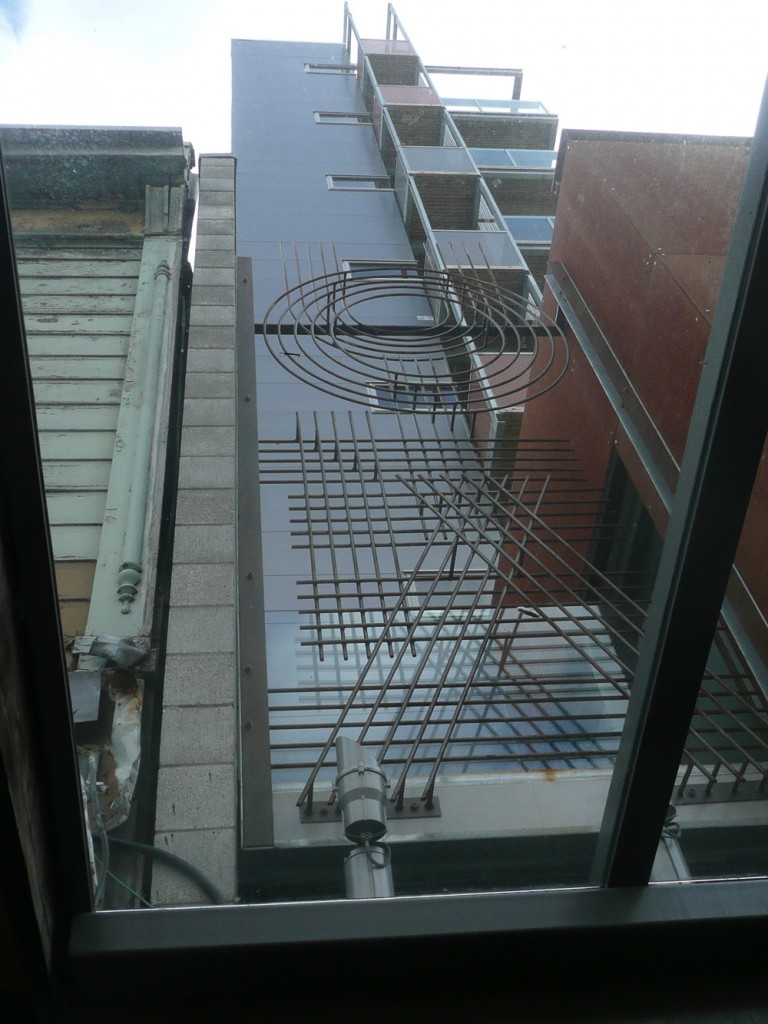Two articles about women architects today – on the one hand there is the story of architect Karen Krogh, who has tasted the life of the developer and does not like it, and on the other flipper there is a story of an architect who practically lives in the ocean, wrapped in rubber, breathing verrrrrrry slowly. Hmm, that sounds fishy – very Fishy. I wonder if she is related?

Palmerston North architect Kathryn Nevatt “finished with world No 1 rankings in static apnea with a breath hold time of seven minutes and 34 seconds and dynamic without fins at a (horizontal) distance of 158m on a single breath, swimming a form of underwater breaststroke.” Ouch. Nearly 8 minutes without breathing. And, as far as I know, she doesn’t have gills, although some gilliweed and a temporary transformation into a mermaid seems highly likely.

But, as entertaining as architects as mermaids may be, the other story is really far more relevant to most of us: an architect tries to take on the developers at their own game, but finds the going rather tough. Of course, anyone building a new apartment building in the midst of a global financial crash is going to find things difficult. But the same issues are going to happen to anyone – aren’t they?

———————
“The Cubana apartment block in Cuba St was a financial disaster, which shows how difficult it will be to rebuild a lot of earthquake-risk city buildings, says architect and developer Karen Krogh. … the project began with the purchase of an old Cuba St shop that was under notice, requiring it to be strengthened or demolished.
“We pulled the old building down. It took about five minutes and it came down in a pile of dust. It was a miracle that building stood up.”
To fund the development and make it work financially, she designed an eight-storeyed block to the maximum height allowed by the town plan. It was an expensive site to develop, because it was narrow and deep, and no expense was spared to ensure it was top quality, she said. The project was completed in 2009 and it won an architectural award, but the timing was wrong and it was caught by the global financial crisis. The apartments were sold and people loved them, but the ground-floor shop/restaurant premises were never filled. At one stage, a tenant was lined up, but then pulled out. A subsequent attempt to sell it came to nothing and it is now up for mortgagee sale. But Krogh said that even if that had been filled from the start, the project would not have been a financial success. All 14 apartments sold, but for less than they cost to build.
“We put our heart and souls into it. Out timing was appalling – nobody saw it coming – and I knocked myself out for it, and I’m now just trying to pick myself up and make something positive out of it.”
But the experience left her wondering how Wellington’s old earthquake-risk buildings would be rebuilt, who would do it and what it meant, particularly for an old part of the city like Cuba St. Krogh lamented the huge costs of any sort of development, including council reserve contributions, compliance costs and the ticket clipping by all the men in suits – lawyers, consultants, financiers and others – who had to approve everything without adding any value.
“It ends up making it too expensive to do anything. …People bang on about how all our housing is overpriced, but it is too expensive to do it properly and that’s why people build dog boxes. It is a difficult process to think you can redevelop the city in a quality way and redevelop earthquake-prone buildings. ….It’s the same problem in Christchurch. The reality is a nightmare. We need to go back to the basics and think what we really need.”
So – what are the real issues?








I think that the footprint for that development may have been too small eg you need a lift and a stairwell, it doesn’t make a huge cost difference whether they service 14 or say 30 apartments. Perhaps there is a quorum no of apartments that make the breakeven point?
The Council do clip the ticket a bit too much but I don’t think that that is the killer
Anyone want to take a stab at a number below which it is not worth it or am I on the wrong track?
Not sure that there is definitely a minimum number, but the need for a lift will add a minimum 100k into any development right up front. To be honest, and I hate to say it, but I think the reason the price point wasn’t achieved on these, was poor design and crappy construction, coupled with the fact that no one in their right mind would want to live in a noisy environment like Cuba St, right opposite the San Fran Bathhouse and a late night environment full of drunken rockers. I’d keep the hell away from that!
This part has me puzzled: “….and no expense was spared to ensure it was top quality, she said.”
Developers tend to analyse the end user / purchaser, maximum price the purchaser would be prepared to pay (given the location and other variables), then design and cost engineer until a reasonable profit can be garnered from the development.
Possibly Karen, intending to design and build something she’d be proud of, lost sight of the basic calculations.
How much extra does it cost for sound-proofing per floor?
And while ‘compliance costs’ is a factor, it’s become a convenient scapegoat for poorly-run businesses. Could public sector cuts and talent poaching by Auckland and Sydney be another factor?
I’ve got to say here that I really don’t want this to be a bashing of K Krogh – I have the utmost respect of her, because she did something that all architects seem to shy away from – ie put their money where their mouth is. She stuck her neck out, and stuck to her guns – and got this building built which is a major addition to Cuba St, and the first new building in that part of town for, oooh, i dunno, maybe 30 years? So I say: good on her.
But it is true that there are issues. There is the location as Alan says – you’d have to be keen on late nights to live near there. I hope they have double glazing in Cubana. There is no car parking – nor should there be – in Cuba St, but that will stop the people that simply Must have a car. They tend to be richer. So: none of them. And then there is the design – its a very skinny site – which leads to a very skinny design. Some of the rooms are stretched. It’s a clever adaptation for a tricky site – but is it too much? Is the design compromised as a result? And lastly, from me, there is the question of view. Is the site going to get built out? What happens if someone builds another Cubana next door? Where does that leave you then?
Speaking of “temporary transformation into a mermaid” – I have added a couple of photos of mermaids – thanks and all credit to Benz, the photographer – they are not pictures of Kathryn I hasten to add.
Did you know that there is a whole genre of mermaid porn? No, neither did I. There is no end of man’s creativity when it comes to wrapping women up in bizarre costumes.
Which reminds me – its Fashion Week next week. Expect more women to be trussed up like turkeys, although possibly no mer-porn.
A girl I went to high school with, a world champion free diver – who’dve thunk it?
Did she breathe then? Because clearly she doesn’t now…. 8 minutes! I start expiring after 30 seconds !
At first (and second) glance the mer-pics seem eerily similar to another recent example of career hyphenation:
http://www.artknowledgenews.com/11_12_2011_22_24_53_the_govett_brewster_art_gallery_to_survey_works_by_filmmaker_vincent_ward.html
Temporarily embarrassed though KK might be, let’s cheer for the way Cubana brings more people to the neighbourhood without taking anything away and admire the way it sits in its street. Then, let’s think about what horrors might be coming to the scruffy site next door if more calculating builders get their hands on it.
Hmmm, Born in a Caul – looks much like the Virgin in a Condom from Te Papa’s infamous past…
I was just looking at Cubana last week. I think the narrowness is quite daring. I like buildings that get away from the “normal” size ratios that we inherited from the pre-modern era. But… There is no way I’d touch the place given the likelihood of losing all your side windows to new developments on either side.
Oh, and does the architect work part time as a super hero? She’s at her day job but has forgotten to take her super hero face mask off.
David – regarding the view and the side walls – when I spoke to Karen about this building back in 2010, she was quite clear about her understanding that the building immediately to the north of Cubana – ie the Deco one – had a height limit that meant it could not be extended up that far. I think it was from level 4 up that was free as a bird in terms of view. Which is why it has a lot of glass to the north side.
Can’t remember what she said about the south side, although obviously the blankish wall looks like it accepts that one day the old buildings there will go.
One more thing – haven’t you got a better photo of Cubana than that tired old work-in-progress shot?
After all, it has been finished for years…
seems like a perfect storm of timing and site restrictions – which as Maximus points out is a shame with an alluring site and admirable intentions.
However at a fundamental level,I’ve never seen a viable development with only 2 apartments per floor when they are not all of ‘penthouse’ quality with carparks, views etc. The minimum I’ve seen developers go to is 4 apartments per floor. Still an interesting addition to that park of Cuba Street…
Exciting new photo added for fussy readers who complain about a bit of historical action, and hello again to Simon BK. Mmmm, Burger King, home of the Whopper. Nice to hear from you SBK – although I guess you aren’t to know that “a perfect storm” is one of my pet hates as a phrase. Coined by that stupid film with a sinking fishing boat, and used ad nauseum ever since, but I’ll forgive you this once.
I think everyone has really hit the nail on the head with this – the project was probably never that financially viable, to be perfectly honest. The downsides are numerous: the site is too skinny, the footprint too small, the location too noisy, the neighbours potentially too tall. Materials such as precast concrete panels and giant steel framing don’t come cheap, and tenants are bound to be picky in an area that is funky, groovy, and ultimately down in the economic dumps. Coupled with that, the project architect (Perry Architects) seems to have vanished off the face of the earth, and you’re not really left with a happy pile of bunnies.
Back soon, I promise !
Just…. a wee bit busy at the mo.
Any suggestions for the next topic? Or are you ok with me just leaving that lovely mermaid up there, freezing her tits off?
Perhaps the new temporary Chch cathedral* – I’m curious as to the healing quality of togetherness (stay with me on this one) of the crowd at the Chch Super12/18/whatever game.Ok it’s rugby but more importantly , can a structure cause a crowd to collectively normalise their shared experience?
Do buildings influence people or are people just going to use them for their own purposes regardless?
Not trying to deflect attention away from the fish’s eye but we’ve got a really interesting situation just one city South from us and frankly there’s SFA construction action in town at the mo.
By the way, thanks for telling us all that there is such a thing as mermaid porn – I am now scarred forever.
*the word “cardboard” is now ineluctably linked with that structure
60, have you been reading Dan Brown’s The Lost Symbol at all? ;)
Max, have you been up to that house on Seatoun Heights Rd, near Khyber Rd lately? (I haven’t.) How’s it looking?
Accusing someone of reading Dan Brown is pretty bloody low…
Aside from Dan Brown, if you want to look at some great design (note: not architecture), then there is an absolutely first class design exhibition on up at the Victoria Uni School of Design at present. Absolutely gorgeous thingummies made on 3-d printers – quite superb. Probably only here till the weekend – part of DesForm conference – go grab it now!